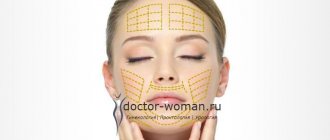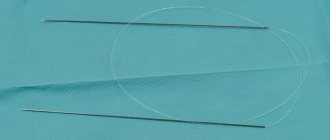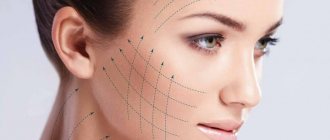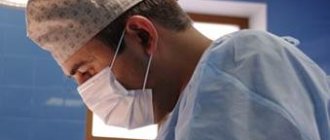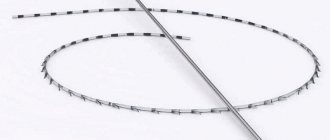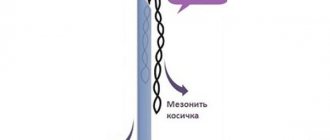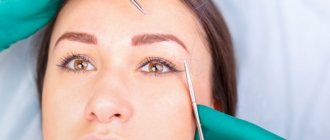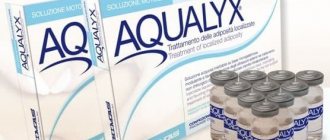Innovations in aesthetic medicine make it possible to preserve youth for as long as possible. Thanks to the use of mesothreads, it is possible to achieve the effect of plastic surgery in just one procedure. In cosmetology, biodegradable material is used, which dissolves after several months. During this period, a dense collagen frame is formed in its place; it supports the shape created during correction. A special feature is the use of high-quality materials that do not cause allergies or tissue rejection, which reduces the risk of complications.
The short recovery period lasts about a week, and the results can be enjoyed for several years. The procedure allows not only to smooth out wrinkles and restore the oval line, but also to model facial features. Thanks to reinforcement, you can lift the corners of your mouth, eyebrow line, create prominent cheekbones, and get rid of drooping eyelids. What are the features, to solve what problems are cosmetic mono threads used, we will look into it further.
Description of threads
Cosmetic linear threads are the easiest implant to install. The smooth structure and small diameter allow for rejuvenation for various areas of the face, the length ranges from 2.5 to 9 cm. Made of polydioxanone, a material that dissipates within 6-8 months.
Hypoallergenic properties do not cause rejection or unexpected reactions. It breaks down into carbon dioxide and water and is eliminated from the body without consequences.
NiTi K-files CC+ nickel-titanium flexible files NITIFLEX
Nickel-titanium K-Files (NiTi K-Files) packaged (in cassettes of 6 pcs.) - hand-held endodontic instruments intended for endodontic treatment of complicated caries:
- to provide the root canal with an optimal size and shape for irrigation and subsequent filling.
- for mechanical treatment of strongly curved (curved) root canals: expansion of the lumen of the already passed root canal and alignment of its walls with reciprocating (sawing) movements.
2. Special properties of the product.
Nickel-titanium K-File (NiTi K-File) consists of a handle, a metal rod with a working part (a section of the rod intended for performing endodontic manipulations) and a stopper pre-installed on the rod. The tool handle is made of plastic, the rod is made of nickel-titanium alloy, the stopper is made of silicone. The working part is a spiral with cutting planes and a non-aggressive (non-sharp) tip.
An important design feature of the tool is the features of the SS + handle:
The material from which the handle is made allows it to be sterilized at a temperature of 270 degrees. The shape of the handle (narrowing in the central part and circular notches) provides: reliable fixation of the tool in the fingers and excellent tactile sensitivity. The pronounced ribbing of the handle ensures the stability of the tool during processing. In addition, the CC+ handle allows you to more evenly distribute pressure on your fingers, thus ensuring less fatigue and increasing the efficiency of the working part of the tool. A special hole is designed for a safety thread to prevent swallowing and aspiration of the instrument. The length of the tool is marked on the handle. The color of the handle corresponds to the ISO size of the tool.
Nickel-titanium K-File (NiTi K-File) Antaeos is made from a nickel-titanium alloy by milling (turning) due to the flexibility of the workpiece and is characterized by flexibility five times greater than the flexibility of steel tools and elasticity (they do not remember the shape of the channel even after the leads from it remain smooth) The symbol - the letter N is marked on the handle.
The instruments do not contain toxic, binding substances or chemicals.
Potential risk of use is fracture of the instrument if used incorrectly.
Indications for use
Monofilaments are indispensable for correcting areas of thin, sensitive skin. Thanks to the implant, it is possible not only to achieve lasting rejuvenation, but also to remove drooping eyelids and drooping corners of the mouth. Do not use for ptosis, as well as in areas with dense skin, with pronounced age-related changes.
Important! The greatest effect can be achieved between the ages of 30 and 40 years.
Indications for:
- expression wrinkles;
- oval line offset;
- drooping eyelids;
- crow's feet;
- facial asymmetry;
- drooping corners of the mouth and eyes;
- decreased firmness and elasticity.
Thanks to reinforcement, it is possible to achieve a natural rejuvenation result. The method is ineffective for skin diseases, severe ptosis, bumpy, uneven relief. Combines well with various hardware and injection cosmetology methods.
Overview of manufacturers and types of threads
Valencia are produced in South Korea, mesothreads are represented by needle-shaped types. They are particularly thin and durable, which allows you to work with large volumes of skin. Recommended for correcting facial wrinkles, restoring oval shape, and eliminating ptosis. Suitable for sensitive skin prone to allergic reactions. The healing period lasts up to 2 weeks. Cost about 2000 rubles.
Kog Aespira - unidirectional notches are located along the entire length of the implant. Threadlifting with peptides not only provides noticeable rejuvenation, but also eliminates pigmentation. Produced in South Korea and developed in an Austrian laboratory, they meet international quality requirements. Aespir monofilaments also provide a depigmenting effect, prolonging the correction effect. The cost of linear thread is for 1 piece. - 1400 rubles, needle - 3600 per unit.
Darwin - mesothreads are produced in Italy and have a pronounced long-term effect. They are used for correction and prevention of age-related changes in the face and body. Reinforcement requires a smaller number of threads compared to other manufacturers. The implantation procedure is not traumatic; 29G needles are used. Meets international quality requirements, certified in Russia. The cost of a package including 5 pcs. about 5000 rub.
Miracu - produced in Korea by the Dongbang company, threadlifting is characterized by low trauma, thanks to the diamond sharpening of the needles. Traces after reinforcement are almost invisible, which allows you to shorten the rehabilitation period. Cost 1 piece. about 3000 rubles, used to eliminate crow's feet, also for a circular facelift.
Description of Kogi threads
Kogi threads for face lifting are cosmetic threads made from natural biomaterial, absolutely compatible with the tissues of the human body. Kogi threads differ from other mesothreads by multiple converging and diverging notches called Cog (translated from English cog means tooth).
Reliable fixation of Kogi threads inside the subcutaneous layer of the dermis is ensured by straightening the notches.
Kogi mesothreads consist of a puncture needle, a hollow soft tube with a hard pin inside it (cannula) and a voluminous mesothread with notches. The needle is made of high-quality heavy-duty medical steel. Laser sharpening of the needle makes it easy, low-traumatic and almost painless to insert mesothreads under the skin.
Kogi mesothreads come in the following types:
- PLLA threads are particularly durable. The threads contain polylactic acid, which enhances collagen production and provides lifting similar to the effects of fillers. Threads of different lengths (90 - 150 mm) allow them to be used for reinforcing different areas of the face and tightening the skin on the neck. The effect lasts for a year;
- PDO - mesothreads are made from polydioxanone (monofilament suture material). Absorbs from six months to a year, leaving a natural collagen framework that lasts for about 2 years;
- DOUBLE COG is a thread with double-sided herringbone knurling. In case of laxity and looseness of the dermis, it perfectly tightens it and retains its shape perfectly;
- single-sided threads have multidirectional notches on only one side of the thread body. Recommended for use in mild age-related skin deformations;
- multidirectional threads are equipped with multidirectional notches around the thread. An excellent result is achieved in the case of sagging skin (the “baked apple” effect), with a deficiency of subcutaneous fatty tissue. Recommended for use for tightening and fixing large areas of skin.
Today, cosmetologists have 3D and 4D Kogi threads available to them:
- 3D - Kogi threads have notches in three directions around the thread, used for enhanced lifting of the middle area of the cheeks and cheekbones. The insertion of threads is quite painful, so it is performed under local anesthesia. The procedure is simple and can be performed by a well-trained, experienced cosmetologist;
- 4D – threads have numerous notches in 4 directions. Inserting a thread is a rather complicated procedure and can only be performed by a plastic surgeon. The effect is almost immediate.
First of all, when choosing the type of threads, the patient’s age and the characteristics of his skin (the degree of sagging of the facial skin, the thickness of the subcutaneous fat layer, etc.) are taken into account.
Preparation before the procedure
The main task of the preparatory stage is to identify possible contraindications. During the consultation, the doctor interviews the patient and collects anamnesis. You may need to be examined by specialized specialists, as well as undergo tests - a general blood test, a coagulogram to check coagulation, a test for hepatitis, HIV. These are standard studies before procedures involving violation of the integrity of the skin.
The work plan, implantation tasks, and mesothread material are also determined. Several types are often used to achieve the most natural result. The doctor assesses the condition of the skin and informs the patient what problems can be solved with the help of thread lifting.
Preparation for the event:
- You need to stop taking medications 2 weeks before;
- within a week, you cannot carry out cosmetic procedures that involve trauma to the skin;
- for several days it is not recommended to smoke or drink alcoholic beverages;
- the restrictions also apply to the menu, so that the recovery period passes quickly and without complications, it is worth excluding spicy, hot, salty dishes;
- it is necessary to reduce physical activity and sports.
How does the procedure work?
First, a consultation is held, where the doctor finds out contraindications, the characteristics of the patient’s skin, and develops a plan for the procedure. It is important to choose a trusted clinic and an experienced, qualified doctor to avoid unforeseen complications.
You should also pay attention to the expiration date, quality certificates of mesothreads; the packaging is opened only in front of the patient. It is not recommended to eat heavily on the day of the event; it is better to arrange a fasting day for yourself.
A threadlifting session takes from 40 to 60 minutes, depending on the area of correction.
Note! After the procedure, the patient can go home; the condition does not require further monitoring by medical personnel.
Stages:
- Makeup removal is carried out using professional products.
- The skin is treated with an antiseptic solution at least 3 times.
- A special marker is used to mark the threads for implantation. Administration schemes are grids or parallel lines and are developed individually depending on the condition of the patient’s skin and the assigned tasks.
- If the pain threshold is low, an anesthetic cream is applied, and pain relief can also be provided by injection. Linear threads usually do not cause discomfort; it is advisable to use them when reinforcing materials with notches.
- The threads are inserted using thin needles; after installing all the units, the doctor removes them one by one, fixing the edge with a finger. Next, the frame is tensioned.
- The puncture sites are treated with an antiseptic, and restorative agents are applied to the skin to relieve puffiness and swelling.
To correct the forehead and chin, you will need from 10 to 15 pcs. To tighten the cheek area - from 10 to 15 units on each side, eyebrows - 5-10 units on each side. Circular lift - from 40 to 50 threads, neck - 20 pcs., nasolabial wrinkles 5-10 pcs.
Action of threads
Kogi threads are implanted into the dermis of the face and, due to multiple multidirectional incisions, are securely fixed, providing the necessary tension to tighten the facial skin. They are introduced using small punctures and inserting a needle and thread under the skin. Then the needle is removed, leaving a taut thread in the specified direction.
The whole procedure takes a little over half an hour. First, the skin is well cleaned and disinfected with an antiseptic. Then, with a special marker, the pattern of threads is applied to the skin. An anesthetic cream is applied to the skin to reduce skin sensitivity. And after 10-15 minutes, when the skin is sufficiently frozen, threads are inserted.
To do this, small incisions or punctures are made in the skin. The thread is inserted under the skin to a depth of 3-5 mm and then pulled using a cannula along the marked lines. The doctor monitors the accuracy of thread insertion using a camera. Accuracy plays a huge role, since needle threads can cause microtrauma when pulled through the skin.
After installing the mesh, the doctor pulls the threads, using notches and knots, secures them, forming a strong frame. Then sutures are placed on the incisions and an elastic aseptic bandage is placed on top. The doctor removes this bandage a week later, after examining the patient.
Everything is strictly sterile, the threads must be unsealed in front of the patient.
If pain relief with cream is not enough and the patient still feels pain, an injection of lidocaine or ultracaine is given. The entire operation does not last long, on an outpatient basis. The patient can go home immediately. The rejuvenating effect is maximally manifested after about a month, although a visible improvement in the condition of the skin is observed immediately after the procedure.
The action of Kogi threads occurs in three stages:
- provide good tightening in the deep layers of the dermis, thanks to notches;
- in the connective tissue cells around the threads, the production of elastin and collagen is enhanced, its metabolism and renewal are accelerated. The structure and quality of the skin, its microcirculation are noticeably improved;
- When resorbed, they form a fairly strong collagen frame, which ensures the formation and fixation of the required contour of the face and body.
Depending on the condition of the skin, the doctor calculates the required number of threads required:
| Forehead and chin lift | Cheek lift, jowl removal | Smoothing of the nasolabial triangle | For a circular lift |
| 5-7 pieces each | 12-15 threads | 6-8 pieces | 40-50 threads |
Kogi threads not only help to secure the skin, they allow you to move and “tighten” it. A correctly performed procedure visually tightens and straightens the oval contour of the face, removes medium and small age wrinkles.
This procedure is recommended by doctors to patients aged 35 to 50 years, with slight sagging of the skin and swelling of the oval of the face. With severely weakened skin tone and severe ptosis, Kogi threads will not be able to give the desired result. In such cases, the patient is recommended to undergo abdominal or laser cosmetic surgery for a facelift.
Healing period
Despite the swelling after correction, the effect can be assessed immediately. The result will gradually increase over the course of a month. The first week the integument is restored after reinforcement. Swelling, hematomas, and painful sensitivity may persist for up to 10 days. To speed up healing, no additional manipulations are required; it is important to follow medical recommendations.
Recovery period:
- for the first 3–5 days, hygienic care is carried out using sterile wipes and an alcohol-free antiseptic solution; after cleansing, Bepanten ointment is applied;
- It is not recommended to touch your face with your hands, you should sleep in a supine position, change your pillowcase daily;
- it is necessary to refrain from strong emotional manifestations;
- For a month, you should limit sports activities; you cannot visit the sauna, swimming pool, or solarium.
The threads dissolve within 4–8 months, during which time a dense collagen framework is formed. The pronounced lifting effect lasts for about 2 years, after which the procedure can be repeated. When combined with other types of mesothreads, as well as the use of mesotherapy, biorevitalization, hardware therapies, the result can be prolonged. The reduction processes are influenced by factors such as the patient’s age, skin care, and lifestyle.
Types of threads for lifting
The use of threads allows you to tighten sagging areas of the skin and increase its elasticity, smooth out wrinkles, and make the outline of the face clearer. Depending on the result you want to get, facial features and the severity of age-related changes in the patient, cosmetologists and plastic surgeons use different types of threads. There are a great many types of these, but the following are most often used.
Smooth (Tissulift)
They consist of intertwined silicone, polyamide and polyurethane fibers. The surface of surgical threads for facelift is smooth, the threads do not undergo biodegradation (resorption). They are placed in the form of a loop in the deep layers of the skin, secured to the bone tissue, so they provide high-quality tightening even with severe sagging tissue. The method involves making incisions under local or, in some cases, general anesthesia, so it is usually performed in an operating room.
Mesothreads (3D mesothreads)
The thinnest among absorbable lifting threads, they are usually inserted using a blunt-ended cannula, which does not pierce, but moves the tissue apart. Therefore, the technique is the least traumatic, but requires precision movements and special professionalism from the doctor. Incorrect movements can lead to tightening of the skin and deformation of facial features.
The threads dissolve in the skin after six months, but during this time a collagen framework is created in their place, which provides a supporting effect (this statement only causes a skeptical grin from many doctors) for about two years. But still, the result of their use is the most gentle, so they are not suitable for people with severe age-related changes.
They are used at the first signs of aging or as its prevention - which is more likely to be true - in patients 30–40 years old. It is quite possible to insert mesothreads in a regular beauty salon with a professional cosmetologist, and it is not necessary to contact a plastic surgeon.
Aptos serif threads
Their peculiarity is the presence of barbs, which help the thread to gain a foothold in the tissue, clinging like hooks. The thread is inserted into the subcutaneous layer to a depth of 3–5 mm using a microscopic puncture. Several types of Aptos threads have been developed for lifting different parts of the face (for example, “hammock” threads for correcting a double chin or “spring” threads for the cheeks and nasolabial folds). There are biodegradable threads made from polylactic acid, the effect of which lasts for 2 years, as well as non-degradable threads made of polypropylene, which retain the result for about 4 years.
Rehabilitation lasts about 2 weeks; it is recommended to restrain active facial expressions for a month. As with other types of thread lifting, Aptos threads should only be administered by professionals.
PS My cosmetologist says that she is afraid to use these threads for her patients precisely because of the long time it takes for them to be absorbed inside the body. Like, it’s one thing for the random negative effect of an unsuccessful introduction to last a year, and another for four!
Cone-shaped combined threads (Silhouette Soft)
They have nodules and cones, and thanks to them they are fixed in the tissues in the right places. The base of the thread is made of non-degradable polypropylene, and the knots (usually 8-11 of them) and cones are made of glycolide and lactic acid copolymer, which gradually dissolve, but in their place a capsule of connective tissue is formed, providing a further tightening effect. Used to correct the shape of the face and tighten the skin.
The disadvantages of these threads include tubercles that can protrude in the temple area where the nodules are attached. Recovery takes about two weeks, during which time swelling of the face is observed. For a month, it is not recommended to smile, laugh, or make faces. The cost of this technique varies from 45 to 90 thousand rubles. The price depends on the number of threads used and correction tasks. A facelift is best used by women under the age of 50, since with severe sagging skin, it may not be very effective.
How much does the procedure cost in Moscow?
The procedure is carried out in clinics and aesthetic medicine centers. The technique is quite complex; the threads are installed in the middle and deep layers of the dermis. Therefore, it is important to pay attention to the qualifications and experience of the doctor. Product quality certificates, the reputation of the clinic, and compliance with sterility conditions are also important. A preliminary consultation is required, the condition of the skin is assessed, and the cost of thread lifting is calculated. It is necessary to undergo tests; additional examination by specialists may be required to exclude contraindications.
The cost of implantation in Moscow is 1 piece. monofilament from 600 to 3000 rub. Depending on the correction of one area or neck lift, you will need from 20 to 60 pieces. The price varies from 12,000 rubles. up to 50,000 rub.
Comparison of Kogi threads with other types of mesothreads
Today, aesthetic medicine has at its disposal, in addition to Kogi threads, two more types of mesothreads:
- linear – for rejuvenating the neck line, décolleté area and eliminating the double chin. They are characterized by low cost and ease of installation;
- spiral - universal threads. The length of such a thread when stretched is from 50 to 60 mm. They are most often used in combination with other types of mesothreads to correct the décolleté area, nasolabial folds, and fine age wrinkles.
The figure shows the types of Kogi threads for face lifting.
Kogi threads differ from them in a more pronounced quick result, thanks to the notches. These notches, like anchors, hook and pull the tissue, reducing and securing the treated area. The excellent lifting effect from the introduction of Kogi threads can last from 3 to 5 years.
In addition, the advantage of Kogi threads is their biodegradation - Kogi threads dissolve in the body over time, breaking down into carbon dioxide and water, and are completely eliminated from the body. These threads are absolutely hypoallergenic and compatible with other drugs and plastic medicine techniques.
Contraindications
There are restrictions for thread lifting:
- pregnancy, lactation;
- menstruation;
- postoperative period;
- purulent-inflammatory process in the area of reinforcement;
- the presence of metal implants;
- autoimmune diseases;
- oncology;
- diabetes;
- tuberculosis;
- acute respiratory diseases;
- increased body temperature;
- tendency to form colloidal scars;
- blood clotting disorder.
Contraindications to the introduction of threads
Those who decide to use non-surgical rejuvenation technology should carefully study a number of reasons that will become an obstacle to the procedure. Fortunately, there are few of them:
- pregnancy period;
- breast-feeding;
- infectious diseases;
- poor blood clotting;
- inflammatory processes of soft tissues of the face;
- structure of the epidermis (thick skin);
- allergic reactions;
- oncological diseases;
- diabetes;
- severe sagging of fabrics.
The last of these reasons is not a death sentence for a woman. In this case, she will be recommended plastic surgery that can cope with almost any degree of sagging of the soft tissues of the face.
Side effects
Carrying out reinforcement in a trusted clinic by a qualified, experienced doctor reduces the risks of unforeseen effects. Implantation of monofilaments requires practice and professionalism; the material is very thin and can break if subjected to strong tension.
Possible side effects:
- swelling, hematomas go away on their own within a few days, with a longer recovery they are caused by problems with blood clotting;
- bruises appear when the technique is violated;
- pain persists for 3–4 days; to eliminate discomfort, the doctor may prescribe painkillers;
- facial asymmetry is corrected by repeated correction, caused by a medical error;
- irregularities and tubercles are observed when the threads are inserted incorrectly;
- lack of results can occur if the number of implanted threads is insufficient.
Attention! The inflammatory process occurs when sterility conditions are not observed during the procedure or when hygiene standards are violated by the patient during the rehabilitation period.
Comparison with other types of mesothreads
Linear or monofilament threads are thin and can be used for sensitive areas of the face - eyelids and mouth. It is not advisable to use for tightening areas with dense skin; combination with other types of materials is effective. The cost is cheaper than spiral and needle ones, but correction will require a larger number of units.
Spiral - are twisted threads, after installation they tighten the skin thanks to the properties of the spring to retain its shape. They are used on different parts of the face and body, and are prescribed to correct the corners of the lips, eyebrows, and nose. Implantation is carried out in the subdermal layers, without reaching the subcutaneous tissue.
Braids are monofilaments woven in a special way that provide sufficient strength. The diameter allows use only for thick skin where expressive lifting is required. It is used for a circular facelift and neck lift. Implantation occurs in the deep and middle dermal layers, as well as muscle tissue.
Needle - mesothreads with notches. Depending on the type - Rose, Kogi have different directions. They are distinguished by reliable fixation, the use allows you to achieve a longer-lasting effect reaching 5 years. Prescribed for pronounced age-related changes, where lifting of a significant amount of skin is required. The result is a natural appearance thanks to the creation of a strong frame. The cost is an order of magnitude higher than other types of mesothreads, but fewer units are used for the procedure.
A few words about non-surgical facelift
Approximately twenty to thirty years ago, if it was necessary to get rid of pronounced age-related changes in facial skin such as jowls, a sagging oval and a sagging chin, cosmetologists advised only one option - plastic surgery. Not all women could decide on it. Some were embarrassed by the cost of this procedure, others could not afford the operation for medical reasons, and still others were categorically against surgery of this kind. In addition, the rehabilitation period after such a procedure could last several months, which not many ladies could endure.
However, about fifteen years ago, cosmetologists increasingly began to offer their clients non-surgical facelifts using Kogi threads. Reviews from delighted patients have made this method of regaining lost youth extremely popular and it is now successfully used in many countries around the world.
Cosmetologists themselves advise using the technique in cases where other procedures no longer produce noticeable results, but you do not want to undergo surgery. A good doctor usually first offers women biorevitalization, laser resurfacing and other gentle procedures. Only after the entire limit of such techniques has been exhausted, is it worth thinking about Kogi threads for a facelift. Reviews make it possible to understand that, depending on the type of skin and the rate of aging, this can be done no earlier than thirty-five years.
Advantages and disadvantages
The use of monofilaments allows you to restore firmness and elasticity in the eyelids and mouth. It is optimal to carry out correction for unexpressed age-related changes, in this case it will be possible to achieve the maximum effect. Before prescribing a procedure, it is important to weigh all the advantages and disadvantages of thread lifting.
Pros:
- short recovery period;
- alternative to surgery;
- the effect lasts about 2 years;
- use of local anesthesia;
- the patient does not feel discomfort during implantation;
- low tissue trauma minimizes side effects;
- the opportunity not only to look younger, but also to correct facial features;
- the most natural result, natural facial expressions are preserved;
- combined with other aesthetic procedures;
- the material does not cause rejection or allergic reactions;
- There is no need to remain under the supervision of a doctor after the implantation is completed.
Minuses:
- high cost of the procedure;
- the result depends on the experience and skill of the doctor;
- If the rules of the rehabilitation period are not followed, side effects may occur.
Opinion of cosmetologists
On forums, cosmetologists share their experience in installing mesothreads.
The user writes about the ineffectiveness of 10 threads for correcting the nasolabial triangle; for each side, 10 to 15 pieces are required.
The review talks about the positive effect of using mesothreads only when there is slight overhang of the nasolabial bag.
A participant writes that mesothreads do not hold paint grease, but smooth out the relief and increase the density of the skin.
Benefits of Kogi threads
Currently, several types of mesothreads are used in cosmetology. They differ from each other in diameter, method of administration and other features. Each type is recommended for certain age-related changes, but most often experts still advise their patients to use Kogi threads, for which the Internet is literally filled with reviews. What are their advantages? Let's list them:
- hold tissue well, which makes the procedure more effective;
- due to the notches, the result lasts up to three years after the threads have completely dissolved;
- have a cumulative effect (cosmetologists advise periodic corrections that enhance the result and do not injure facial tissue);
- practicality (no more than four threads are required for one zone);
- safety, since the introduced material breaks down into water and carbon dioxide.
Also, many ladies write in reviews about Kogi threads that, compared to other lifting methods, they have the shortest rehabilitation period and do not leave scars. In addition, after the procedure, the woman can immediately go home, the recovery period will take place within her own walls.
Patient reviews
On the forums there are mostly positive reviews about the thread lifting procedure.
The review describes a good result and painlessness.
The user writes that, in addition to thread lifting, he uses hardware and injection procedures.
The participant writes about the soft effect of mesothreads, the dependence of the result on weight fluctuations.
The participant writes about the differences between different types of mesothreads and the need for an individual consultation with a cosmetologist.
The review indicates a slight effect after 4 months.
Other reviews can be found on the forum.
